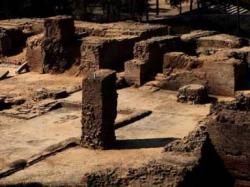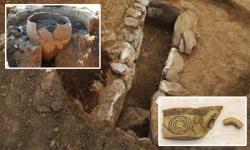INSTITUT SUPERIEUR D'ANTHROPOLOGIE
INSTITUTE OF ANTHROPOLOGY
ONLINE COURSES / COURS A DISTANCE
WINTER TERM : JANUARY 2015
REGISTER NOW
INDE –  Bihar - Bihar's Arts, Culture and Youth Affairs Secretary Anand Kishor said that based on key findings from the excavation, it can be confirmed that Telhara University was older than Nalanda and Vikramshila. "A team of archaeologists has found four Buddhist monastery seals made of terracotta, bearing the inscriptions - Sri Prathamshivpur Mahavihariyaye Bikshu Sanghas - in Pali language in Nalanda district that indicated the university's real name, which is usually described as Telhara University," Kishor said. Kishor said Chinese traveller Heuen Tsang visited Telhara in the 7th century AD and he mentioned the university as "Teleadaka" in his narrative. Kishor told IANS that archaeologists have discovered bricks that were used to lay the ancient university's foundation. "Bricks' dimension 42x32x6 cm revealed a Kushan, first century AD, influence. That is a strong evidence that the Telhara University is older than fourth century's Nalanda University and seventh century's Vikramshila University.". Kishor said the archaeological discovery was a landmark achievement for Bihar. He said archaeologists based on previous findings placed the Telhara University in the Gupta period between fourth and seventh century. But the new findings cleared all doubts as to the university's age.
Bihar - Bihar's Arts, Culture and Youth Affairs Secretary Anand Kishor said that based on key findings from the excavation, it can be confirmed that Telhara University was older than Nalanda and Vikramshila. "A team of archaeologists has found four Buddhist monastery seals made of terracotta, bearing the inscriptions - Sri Prathamshivpur Mahavihariyaye Bikshu Sanghas - in Pali language in Nalanda district that indicated the university's real name, which is usually described as Telhara University," Kishor said. Kishor said Chinese traveller Heuen Tsang visited Telhara in the 7th century AD and he mentioned the university as "Teleadaka" in his narrative. Kishor told IANS that archaeologists have discovered bricks that were used to lay the ancient university's foundation. "Bricks' dimension 42x32x6 cm revealed a Kushan, first century AD, influence. That is a strong evidence that the Telhara University is older than fourth century's Nalanda University and seventh century's Vikramshila University.". Kishor said the archaeological discovery was a landmark achievement for Bihar. He said archaeologists based on previous findings placed the Telhara University in the Gupta period between fourth and seventh century. But the new findings cleared all doubts as to the university's age.
http://twocircles.net/2014dec14/1418563432.html#.VI26-SuG-pA
INDE- Cheyyur - A rapid survey conducted by a city environmental group has claimed the existence of structures of historical and religious importance near the site of the proposed 4000 Megawatt Ultra Mega Power Project (UMPP) in Cheyyur near here, contradicting the conclusions of the project proponents. The survey, done in collaboration with villagers around the area by Community Environment Monitoring, has identified 19 places of historical, archaeological and religious importance within a 10 km-radius of the plant site and has put it in the open for professionals to verify. However, the survey claims that the area actually contains ancient monuments of the Chola era, now in a dilapidated condition requiring immediate intervention. For example, Suresh Sethuraman, the Tamil Nadu State convener for the Indian National Trust for Art and Cultural Heritage (INTACH), in his assessment of a particular ancient Shiva Temple identified in Vedal under the survey, said the temple had been built with the ‘Gajapristha’ style tower using bricks. He said in the assessment that usually, ‘Gajapristha’ style temples were built using stones. Thus, the current one under study in Vedal near Cheyyur, called by locals as ‘Vadavamuganeeswarar temple’, was a “rare specimen.” Stylistically, he concluded that the temple belonged to the late Pallava or early Chola period (eigth-ninth century). The survey findings allege that the identification of several such historical structures ‘vitiates’ the environment clearance provided on the basis of statutory assurances. Therefore, the government has to revisit the choice of the site, which is also ecologically sensitive.
http://www.thehindu.com/news/national/tamil-nadu/survey-report-puts-cheyyur-project-in-trouble/article6691343.ece?
EGYPTE – Louxor - Archaeologists on Sunday unveiled a restored colossal statue of Amenhotep III that was toppled in an earthquake more than 3,000 years ago at Egypt's famed temple city of Luxor. The statue showing him in a striding attitude was re-erected at the northern gate of the king's funerary temple on the west bank of the Nile. The temple is already famous for its existing 3,400-year-old Memnon colossi - twin statues of Amenhotep III whose reign archaeologists say marked the political and cultural zenith of ancient Egyptian civilisation. The 12.92-metre statue unveiled on Sunday stands west of an existing effigy of the king, also depicting him walking, which was unveiled in March.
http://www.straitstimes.com/news/world/middle-east/story/colossal-statue-amenhotep-iii-unveiled-egypt-20141215?
GRECE –  Platamonas - Excavations in Platamonas, Pieria, northern Greece, have unearthed an ancient settlement and burial ground that belongs in the late Bronze Age, around 1500 B.C. The discovery was made in parallel to the construction of the new national highway and was officially announced by archaeologist Sofia Koulidou, head of Pieria’s Ephorate of Antiquities. Archaeologists found 19 graves, some of them containing several objects such as Mycenaean style clay pots, bronze hoops, bone beads, bronze knives, clay flywheels, engraved stones and others. Some of the graves were very small and probably belong to children. The remains of two arched buildings were also discovered, as suggested by the surrounding walls and the holes where the support beams used to be. The buildings were next to each other and it appears that there was a settlement next to the burial ground. The discovery of various household objects reinforces the archaeologists’ assumption. Archaeologists say that this type of rectangular, oblong, arched building belongs to the middle Bronze Age, early 2000 B.C., and are rare in the particular area. The Mycaenean style objects suggest that the settlement was part of the Thessaly-Euobea cultural circle. Overall, the architectural style and discoveries provide valuable information on everyday life, death rituals and practices in the late Bronze Age. The first arch, along with the outbuilding, will be transferred to be highlighted in the Livithra Archaeological Park on east Mount Olympus. Other excavation discoveries in parallel to the national highway construction will be also displayed.
Platamonas - Excavations in Platamonas, Pieria, northern Greece, have unearthed an ancient settlement and burial ground that belongs in the late Bronze Age, around 1500 B.C. The discovery was made in parallel to the construction of the new national highway and was officially announced by archaeologist Sofia Koulidou, head of Pieria’s Ephorate of Antiquities. Archaeologists found 19 graves, some of them containing several objects such as Mycenaean style clay pots, bronze hoops, bone beads, bronze knives, clay flywheels, engraved stones and others. Some of the graves were very small and probably belong to children. The remains of two arched buildings were also discovered, as suggested by the surrounding walls and the holes where the support beams used to be. The buildings were next to each other and it appears that there was a settlement next to the burial ground. The discovery of various household objects reinforces the archaeologists’ assumption. Archaeologists say that this type of rectangular, oblong, arched building belongs to the middle Bronze Age, early 2000 B.C., and are rare in the particular area. The Mycaenean style objects suggest that the settlement was part of the Thessaly-Euobea cultural circle. Overall, the architectural style and discoveries provide valuable information on everyday life, death rituals and practices in the late Bronze Age. The first arch, along with the outbuilding, will be transferred to be highlighted in the Livithra Archaeological Park on east Mount Olympus. Other excavation discoveries in parallel to the national highway construction will be also displayed.
http://greece.greekreporter.com/2014/12/13/after-amphipolis-new-ancient-burial-ground-found-in-platamonas/